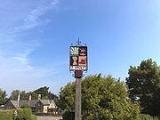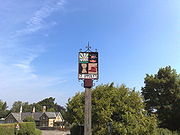
St Ippolyts
Encyclopedia
St Ippolyts is a village and civil parish
on the southern edge of Hitchin
in Hertfordshire
, England
. It has a population of approximately 2,000.

Road) and the B656 (Codicote
Road), two kilometres south-east of Hitchin, Hertfordshire. It lies approximately 80 metres above sea level
in a gap in the Chiltern Hills
.
Some features of the village are a 17th-century gabled house, a timber-framed house formerly known as the Olive Branch Inn, and a 16th-century house built around an even older timbered house.
, the niece of William the Conqueror. De Lens gave evidence against her husband, a Saxon
Earl, which led to his execution. The funding of the church was an attempt to make amends for this act. The church was rebuilt in the mid nineteenth century using old materials 'recycled' from the nearby abandoned Minsden Chapel
. Apart from St Ippolyts, the church also serves the nearby villages of Gosmore and Langley.
The noted theologian Fenton John Anthony Hort
(Fenton Hort) is amongst the former vicars of St Ippolyts church where he stayed for 15 years before taking up a fellowship and lectureship at Emmanuel College
in Cambridge .
Civil parish
In England, a civil parish is a territorial designation and, where they are found, the lowest tier of local government below districts and counties...
on the southern edge of Hitchin
Hitchin
Hitchin is a town in Hertfordshire, England, with an estimated population of 30,360.-History:Hitchin is first noted as the central place of the Hicce people mentioned in a 7th century document, the Tribal Hidage. The tribal name is Brittonic rather than Old English and derives from *siccā, meaning...
in Hertfordshire
Hertfordshire
Hertfordshire is a ceremonial and non-metropolitan county in the East region of England. The county town is Hertford.The county is one of the Home Counties and lies inland, bordered by Greater London , Buckinghamshire , Bedfordshire , Cambridgeshire and...
, England
England
England is a country that is part of the United Kingdom. It shares land borders with Scotland to the north and Wales to the west; the Irish Sea is to the north west, the Celtic Sea to the south west, with the North Sea to the east and the English Channel to the south separating it from continental...
. It has a population of approximately 2,000.

Geography
St Ippolyts is located in between the A602 (StevenageStevenage
Stevenage is a town and borough in Hertfordshire, England. It is situated to the east of junctions 7 and 8 of the A1, and is between Letchworth Garden City to the north, and Welwyn Garden City to the south....
Road) and the B656 (Codicote
Codicote
Codicote is a large village, and civil parish about seven miles south of Hitchin in Hertfordshire, England. It has timber-framed and chequered brick houses, of special interest being the 18th-century Pond House and the half-timbered "As You Like It" Peking restaurant . Codicote Lodge is 18th...
Road), two kilometres south-east of Hitchin, Hertfordshire. It lies approximately 80 metres above sea level
Sea level
Mean sea level is a measure of the average height of the ocean's surface ; used as a standard in reckoning land elevation...
in a gap in the Chiltern Hills
Chiltern Hills
The Chiltern Hills form a chalk escarpment in South East England. They are known locally as "the Chilterns". A large portion of the hills was designated officially as an Area of Outstanding Natural Beauty in 1965.-Location:...
.
Some features of the village are a 17th-century gabled house, a timber-framed house formerly known as the Olive Branch Inn, and a 16th-century house built around an even older timbered house.
History
The name of St Ippolyts, although spelled in a variety of ways, is derived from St Hippolytus to whom the village church was dedicated. According to Daphne Rance in her book on the parish "St. Ippolyts: a country parish in the nineteenth century" (1987) at various times also known as Epolites, Pallets, Nipples or St Ibbs. In the same vein, the 1881 census mentions the following 28 place names, all of which are believed to refer to it: Iplits, Ipolits, Ipollitts, Ipollyts, Ipolytes, Ipolyts, Ippatyts, Ipplits, Ipployts, Ipplyts, Ippolett, Ippoletts, Ippolits, Ippolitss, Ippolits, Ippolitss, Ippolitts, Ippollit, Ippollits, Ippollitts, Ippollyts, Ippollytts, Ippololits, Ippolts, Ippolytis, Ippolyts, Ippolytts, Ippoplitts. The church was built in 1087 in a beautiful setting on the hillside above the village. According to the church records, the building was funded by grants supplied by Judith de LensJudith of Lens
Countess Judith , was a niece of William the Conqueror. She was a daughter of his sister Adelaide of Normandy, Countess of Aumale and Lambert II, Count of Lens....
, the niece of William the Conqueror. De Lens gave evidence against her husband, a Saxon
Anglo-Saxons
Anglo-Saxon is a term used by historians to designate the Germanic tribes who invaded and settled the south and east of Great Britain beginning in the early 5th century AD, and the period from their creation of the English nation to the Norman conquest. The Anglo-Saxon Era denotes the period of...
Earl, which led to his execution. The funding of the church was an attempt to make amends for this act. The church was rebuilt in the mid nineteenth century using old materials 'recycled' from the nearby abandoned Minsden Chapel
Minsden Chapel
Minsden Chapel is an isolated ruined chapel in the fields above the hamlet of Chapelfoot, near Preston, Hertfordshire. Today it is a roofless shell, partly surrounded by a small wood, and accessible only by footpath....
. Apart from St Ippolyts, the church also serves the nearby villages of Gosmore and Langley.
The noted theologian Fenton John Anthony Hort
Fenton John Anthony Hort
Fenton John Anthony Hort was an Irish theologian and editor, with Brooke Westcott of a critical edition of The New Testament in the Original Greek.-Life:...
(Fenton Hort) is amongst the former vicars of St Ippolyts church where he stayed for 15 years before taking up a fellowship and lectureship at Emmanuel College
Emmanuel College, Cambridge
Emmanuel College is a constituent college of the University of Cambridge.The college was founded in 1584 by Sir Walter Mildmay on the site of a Dominican friary...
in Cambridge .
Nearby towns and villages
- GosmoreGosmoreGosmore is a hamlet in the parish of St Ippolyts near Hitchin in Hertfordshire, England. One interesting feature is Bunyan's Dell, a natural amphitheatre deep inside Wain Wood where the author of The Pilgrim's Progress preached in secret when his faith was persecuted after the...
- Great WymondleyGreat WymondleyGreat Wymondley is a village situated near Hitchin in Hertfordshire. It is dominated by its small Norman church with a large apsidal chancel and 15th century nave roof. There are also earthworks of a former motte-and-bailey castle, and Delamere House, an elegant Elizabethan building...
- Hitchin
- Kings Walden
- Little WymondleyLittle WymondleyLittle Wymondley is a village situated between Hitchin and Stevenage in Hertfordshire. Paradoxically, it is larger than its near neighbour Great Wymondley...
- PrestonPreston, HertfordshirePreston is a village and civil parish about south of Hitchin in Hertfordshire, England.The village grew up around the Templar holdings at Temple Dinsley, and Princess Helena College is now on the site...
- Stevenage

